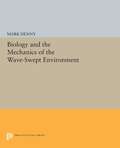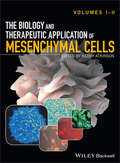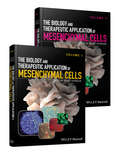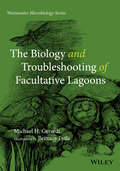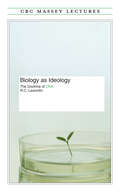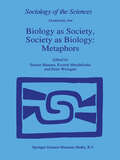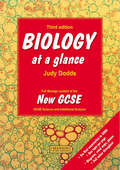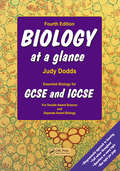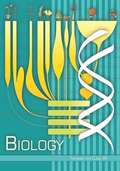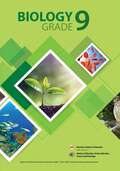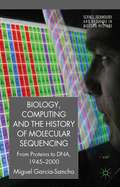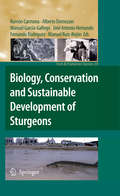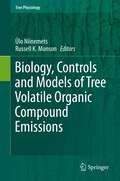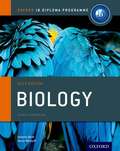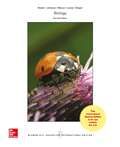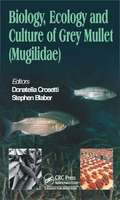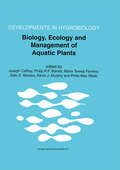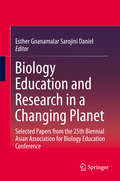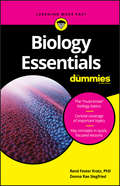- Table View
- List View
Biology and the Mechanics of the Wave-Swept Environment (PDF)
by Mark DennyThis text introduces and draws together pertinent aspects of fluid dynamics, physical oceanography, solid mechanics, and organismal biology to provide a much-needed set of tools for quantitatively examining the biological effects of ocean waves. "Nowhere on earth does water move as violently as on wave-swept coasts," writes the author, "and every breaker that comes pounding on the shore places large hydrodynamic forces on the organisms resident there." Yet wave-swept coral reefs and rocky shores are home to some of the world's most diverse assemblages of plants and animals, and scientists have chosen these environments to carry out much of the recent experimental work in community structure and population dynamics. Until now these studies have been hampered because biologists often lack a working understanding of the mechanics of the wave-swept shore. Mark Denny here supplies that understanding in clear and vivid language.Included are an introduction to wave-induced water motions and the standard theories for describing them, a broad introduction to the hydrodynamic forces these water movements place on plants and animals, and an explanation of how organisms respond to these forces. These tools are put to use in the final chapters in an examination of the mechanisms of "wave exposure" and an exploration of the mechanical determinants of size and shape in wave-swept environments.Originally published in 1988.The Princeton Legacy Library uses the latest print-on-demand technology to again make available previously out-of-print books from the distinguished backlist of Princeton University Press. These editions preserve the original texts of these important books while presenting them in durable paperback and hardcover editions. The goal of the Princeton Legacy Library is to vastly increase access to the rich scholarly heritage found in the thousands of books published by Princeton University Press since its founding in 1905.
The Biology and Therapeutic Application of Mesenchymal Cells
by Kerry AtkinsonThe Biology and Therapeutic Application of Mesenchymal Cells comprehensively describes the cellular and molecular biology of mesenchymal stem cells and mesenchymal stromal cells, describing their therapeutic potential in a wide variety of preclinical models of human diseases and their mechanism of action in these preclinical models. Chapters also discuss the current status of the use of mesenchymal stem and stromal cells in clinical trials in a wide range of human diseases and disorders, for many of which there are limited, or no other, therapeutic avenues. Provides coverage on both the biology of mesenchymal stem cells and stromal cells, and their therapeutic applications Describes the therapeutic potential of mesenchymal stem and stromal cells in a wide variety of preclinical models of human diseases and their mechanism of action in these preclinical models Discusses the current status of mesenchymal stem and stromal cells in clinical trials in a wide range of human diseases and disorders, for many of which there are limited, or no other, therapeutic avenues Written and edited by leaders in the field The Biology and Therapeutic Application of Mesenchymal Cells is an invaluable resource for those studying stem cells, cell biology, genetics, gene or cell therapy, or regenerative medicine.
The Biology and Therapeutic Application of Mesenchymal Cells, 2 Volume Set
by Kerry AtkinsonThe Biology and Therapeutic Application of Mesenchymal Cells comprehensively describes the cellular and molecular biology of mesenchymal stem cells and mesenchymal stromal cells, describing their therapeutic potential in a wide variety of preclinical models of human diseases and their mechanism of action in these preclinical models. Chapters also discuss the current status of the use of mesenchymal stem and stromal cells in clinical trials in a wide range of human diseases and disorders, for many of which there are limited, or no other, therapeutic avenues. Provides coverage on both the biology of mesenchymal stem cells and stromal cells, and their therapeutic applications Describes the therapeutic potential of mesenchymal stem and stromal cells in a wide variety of preclinical models of human diseases and their mechanism of action in these preclinical models Discusses the current status of mesenchymal stem and stromal cells in clinical trials in a wide range of human diseases and disorders, for many of which there are limited, or no other, therapeutic avenues Written and edited by leaders in the field The Biology and Therapeutic Application of Mesenchymal Cells is an invaluable resource for those studying stem cells, cell biology, genetics, gene or cell therapy, or regenerative medicine.
The Biology and Troubleshooting of Facultative Lagoons (Wastewater Microbiology #7)
by Michael H. GerardiProvides personnel a new understanding of how lagoon and fixed film sewage treatment systems work Tested in short-course situations by the author over the last 20 years Directs the material in a practical manner at operators who are responsible for process control and troubleshooting Reduces the jargon, chemical equations, and kinetics that overwhelm most operators and laboratory technicians Provides necessary information for understanding biological and chemical conditions at the treatment process
The Biology and Troubleshooting of Facultative Lagoons: Biology And Troubleshooting Of Facultative Lagoons (Wastewater Microbiology)
by Michael H. GerardiProvides personnel a new understanding of how lagoon and fixed film sewage treatment systems work Tested in short-course situations by the author over the last 20 years Directs the material in a practical manner at operators who are responsible for process control and troubleshooting Reduces the jargon, chemical equations, and kinetics that overwhelm most operators and laboratory technicians Provides necessary information for understanding biological and chemical conditions at the treatment process
Biology As Ideology: The Doctrine of DNA (The CBC Massey Lectures)
by Richard LewontinR. C. Lewontin is a prominent scientist -- a geneticist who teaches at Harvard -- yet he believes that we have placed science on a pedestal, treating it as an objective body of knowledge that transcends all other ways of knowing and all other endeavours.Lewontin writes in this collection of essays, which began their life as CBC Radio's Massey Lectures Series for 1990: "Scientists do not begin life as scientists, after all, but as social beings immersed in a family, a state, a productive structure, and they view nature through a lens that has been molded by their social experience… . Science, like the Church before it, is a supremely social institution, reflecting and reinforcing the dominant values and vices of society at each historical epoch."In Biology as Ideology Lewontin examines the false paths down which modern scientific ideology has led us. By admitting science's limitations, he helps us rediscover the richness of nature -- and appreciate the real value of science.
Biology as Society, Society as Biology: Metaphors (Sociology of the Sciences Yearbook #18)
by Sabine Maasen E. Mendelsohn P. Weingartnot lie in the conceptual distinctions but in the perceived functions of metaphors and whether in the concrete case they are judged positive or negative. The ongoing debates reflect these concerns quite clearly~ namely that metaphors are judged on the basis of supposed dangers they pose and opportunities they offer. These are the criteria of evaluation that are obviously dependent on the context in which the transfer of meaning occurs. Our fundamental concern is indeed the transfer itself~ its prospects and its limits. Looking at possible functions of metaphors is one approach to under standing and elucidating sentiments about them. The papers in this volume illustrate, by quite different examples, three basic functions of metaphors: illustrative, heuristic~ and constitutive. These functions rep resent different degrees of transfer of meaning. Metaphors are illustrative when they are used primarily as a literary device, to increase the power of conviction of an argument, for example. Although the difference between the illustrative and the heuristic function of metaphors is not great, it does exist: metaphors are used for heuristic purposes whenever "differences" of meaning are employed to open new perspectives and to gain new insights. In the case of "constitutive" metaphors they function to actually replace previous meanings by new ones. Sabine Maasen in her paper introduces the distinction between transfer and transforma tion.
Biology at a Glance
by Judy DoddsThis book presents in a clear visual way the biology material needed for the Science and Additional Science GCSE, and for the separate Biology GCSE. It also serves as an introductory guide for AS Biology. It is illustrated throughout with photos and flow charts, with questions on every topic, Internet research activities and a glossary of words to
Biology at a Glance
by Judy DoddsThe fourth edition of a bestseller, this book presents, in a clear, concise, and visual way, the main biological content required by all the examining boards for both the GCSE Double Award Science and separate Biology Award, including IGCSE. It is also useful as an introductory guide for AS Biology. The fourth edition has been revised to include new material on industrial fermenters and their applications, plus additional material on flowering plants.
Biology class 10 - SCERT - Kerala Board: ജീവശാസ്ത്രം മലയാളം മീഡിയം ക്ലാസ് 10 എസ്.ഇ.ആര്.ടി കേരള ബോര്ഡ്
by Kerala ScertBiology Malayalam Medium Class 10 SCERT Kerala Board 1 is divided into four parts. The lessons cover sense organs, brain and nervous systems, hormones and their actions and finally the diseases and reasons. The topics are presented with detailed illustraions and images and tables.
Biology class 12 - NCERT
by National Council of Educational Research and TrainingThe Class XII Biology textbook deals with the physiological process of reproduction in flowering plants and humans, the principles of inheritance, the nature of genetic material and its function, the contributions of biology to human welfare, basic principles of biotechnological processes and their applications and achievements.
Biology class 9 - MIE
by Mauritius Institute of EducationThe Grade 9 Biology textbook from the Mauritius Institute of Education covers four comprehensive units. The first unit delves into the intricacies of the human Blood Circulatory System, exploring the structure and functions of blood, the heart, and blood vessels. It addresses topics like blood cell types, pulse, and cardiovascular diseases. The Reproduction unit explores both asexual and sexual reproduction in living organisms, detailing the structures and functions of human male and female reproductive systems, fertilization, embryo development, and the significance of reproductive health. The Biodiversity unit introduces the concept's importance for survival, explaining how to estimate species using quadrats and addressing factors affecting biodiversity. The final unit, Nutrition in Plants, delves into photosynthesis, emphasizing factors like light, carbon dioxide, water, and chlorophyll, and includes practical demonstrations on starch presence in leaves.
Biology, Computing, and the History of Molecular Sequencing: From Proteins to DNA, 1945-2000 (Science, Technology and Medicine in Modern History)
by M. García-SanchoSequencing is often associated with the Human Genome Project and celebrated achievements concerning the DNA molecule. However, the history of this practice comprises not only academic biology, but also the world of computer-assisted information management. The book uncovers this history, qualifying the hype and expectations around genomics.
Biology, Conservation and Sustainable Development of Sturgeons (Fish & Fisheries Series #29)
by Ramón Carmona José Antonio Hernando Fernando Rodríguez Manuel Ruiz-Rejón Alberto Domezain Manuel García GallegoSturgeons are considered “living fossils”, sharing many morphological and biological features with ancestral fish. Furthermore, sturgeons are of the utmost interest from an economic perspective, not only for the caviar but for the flesh. However, the wild populations of the majority of the species are at serious risk of extinction all over the world. So, it is urgent to develop strategies for both farming culture and conservation and recovery in natural habitats. This book provides a comprehensive view of the biology and sustainable development of sturgeons putting emphasis on the Southern Europe autochthonous species such as Acipenser nacarii and Acipenser sturio that share geographical distribution. Other relevant species (such as Huso huso, A. oxyrhinchus, A. ruthenus, A. stellatus) and areas (Germany, Russia, North America) are also considered. The contents are organised in three sections: Taxonomy and Biogeography (including the morphological and genetic analyses that clarify the taxonomy and phylogeny of sturgeons, focused on those from Southern Europe), Biology and Aquaculture (where several aspects of the developmental biology, feeding, and reproduction are considered in relation to the improvement of sturgeon farming), and Recovery and Conservation (that collates and analyses different recovery research actions, the ecology of the rivers for restoration as well as the problems related to the trade of caviar).
Biology, Controls and Models of Tree Volatile Organic Compound Emissions (Tree Physiology #5)
by Ülo Niinemets and Russell K. MonsonPlant-driven volatile organic compound (BVOC) emissions play a major role in atmospheric chemistry, including ozone and photochemical smog formation in the troposphere, and they extend the atmospheric lifetime of the key greenhouse gas, methane. Furthermore, condensation of photo-oxidation products of BVOCs leads to formation of secondary organic aerosols with profound implications for the earth's solar radiation budget and climate. Trees represent the plant life form that most contributes to BVOC emissions, which gives global forests a unique role in regulating atmospheric chemistry.Written by leading experts in the field, the focus is on recent advancements in understanding the controls on plant-driven BVOC emissions, including efforts to quantitatively predict emissions using computer models, particularly on elicitation of emissions under biotic and abiotic stresses, molecular mechanisms of volatile synthesis and emission and the role of emissions in plant stress tolerance.
Biology Course Companion: Oxford IB Diploma Programme (PDF)
by Andrew Allott David MindorffThe only DP Biology resource developed with the IB to accurately match the new 2014 syllabus for both SL and HL, this completely revised edition gives you unparallelled support for the new concept-based approach to learning, the Nature of science. Understanding, applications and skills are integrated in every topic, alongside TOK links and real-world connections to drive inquiry and independentlearning. Assessment support directly from the IB includes practice questions and worked examples in each topic, along with focused support for the Internal Assessment.
Biology Course Companion: Oxford IB Diploma Programme (PDF)
by Andrew Allott David MindorffThe only DP Biology resource developed with the IB to accurately match the new 2014 syllabus for both SL and HL, this completely revised edition gives you unparallelled support for the new concept-based approach to learning, the Nature of science. Understanding, applications and skills are integrated in every topic, alongside TOK links and real-world connections to drive inquiry and independentlearning. Assessment support directly from the IB includes practice questions and worked examples in each topic, along with focused support for the Internal Assessment.
Biology, Ecology and Culture of Grey Mullets (Mugilidae)
by Donatella Crosetti Stephen J. M. BlaberMullets (grey mullets) are a family (Mugilidae) and order of ray-finned fish found in temperate and tropical waters worldwide. There are approximately 80 species of mullet; these fish have been considered an important food source in Mediterranean Europe since Roman times. This book provides a long overdue update on the biology and ecology of mullet
Biology, Ecology and Management of Aquatic Plants: Proceedings of the 10th International Symposium on Aquatic Weeds, European Weed Research Society (Developments in Hydrobiology #147)
by Ilidio S. Moreira Kevin J. Murphy Philip Max Wade Joseph Caffrey Philip R. F. Barrett Maria Teresa FerreiraThere is a growing need for appropriate management of aquatic plants in rivers and canals, lakes and reservoirs, and drainage channels and urban waterways. This management must be based on a sound knowledge of the ecology of freshwater plants, their distribution and the different forms of control available including chemical and physical, and biological and biomanipulation. This series of papers from over 20 different countries was generated from the tenth in the highly successful series of European Weed Research Society symposia on aquatic plant management, this being the tenth. It provides a valuable insight into the complexities involved in managing aquatic systems, discusses state-of-the-art control techniques and deals with patterns of regrowth and recovery post-management. Careful consideration is given to the use of chemicals, a practice which has come under scrutiny in recent years. Underpinning the development of such control techniques is a growing body of knowledge relating to the biology and ecology of water plants. The authorship of the papers represents the collective wisdom of leading scientists and experts from fisheries agencies, river authorities, nature conservation agencies, the agrochemical industry and both governmental and non-governmental organisations.
Biology Education and Research in a Changing Planet: Selected Papers from the 25th Biennial Asian Association for Biology Education Conference
by Esther Gnanamalar Sarojini DanielThis book presents selected conference proceedings from the 25th Biennial Asian Association for Biology Education Conference. It clarifies the differences between the structure of biology education for educators and researchers. It solves open problems by creating a bridge between biological research and its application in education and the sustainable development of communities. The book’s first topic is Biology Education in an X, Y, Z World, which provides ideas for how biology can be taught in innovative ways. The second topic, The Endangered Planet – How can Biology Education Help? discusses how humans depend on other species for survival and how they have the power to cause or to prevent extinctions. The third and final topic, Research in Biology, encompasses the growing wealth of biological information resulting from scientific research, especially in universities. Educators can use these findings to enhance their teaching.
Biology Essentials For Dummies
by Rene Fester Kratz Donna Rae SiegfriedBiology Essentials For Dummies (9781119589587) was previously published as Biology Essentials For Dummies (9781118072677). While this version features a new Dummies cover and design, the content is the same as the prior release and should not be considered a new or updated product. Just the core concepts you need to score high in your biology course Biology Essentials For Dummies focuses on just the core concepts you need to succeed in an introductory biology course. From identifying the structures and functions of plants and animals to grasping the crucial discoveries in evolutionary, reproductive, and ecological biology, this easy-to-follow guide lets you skip the suffering and score high at exam time. Get down to basics — master the fundamentals, from understanding what biologists study to how living things are classified The chemistry of life — find out what you need to know about atoms, elements, molecules, compounds, acids, bases, and more Conquer and divide — discover the ins and outs of asexual and sexual reproduction, including cell division and DNA replication Jump into the gene pool — grasp how proteins make traits happen, and easily understand DNA transcription, RNA processing, translation, and gene regulation.
Biology Essentials For Dummies
by Rene Fester Kratz Donna Rae SiegfriedBiology Essentials For Dummies (9781119589587) was previously published as Biology Essentials For Dummies (9781118072677). While this version features a new Dummies cover and design, the content is the same as the prior release and should not be considered a new or updated product. Just the core concepts you need to score high in your biology course Biology Essentials For Dummies focuses on just the core concepts you need to succeed in an introductory biology course. From identifying the structures and functions of plants and animals to grasping the crucial discoveries in evolutionary, reproductive, and ecological biology, this easy-to-follow guide lets you skip the suffering and score high at exam time. Get down to basics — master the fundamentals, from understanding what biologists study to how living things are classified The chemistry of life — find out what you need to know about atoms, elements, molecules, compounds, acids, bases, and more Conquer and divide — discover the ins and outs of asexual and sexual reproduction, including cell division and DNA replication Jump into the gene pool — grasp how proteins make traits happen, and easily understand DNA transcription, RNA processing, translation, and gene regulation.
Biology Exam Practice For CCEA A2 Level
by James NapierThis workbook contains practice questions of examination standard for the current CCEA A2 Biology specification. Ideal for revision or to reinforce knowledge. Full answers, marking scheme, tips on common errors and how to maximise marks are available via this link: http://colourpointeducational.com/media/content/A2BiologyExamPracticeMarkScheme.pdf All questions were specially commissioned for this book and are not from past papers. The workbook also contains an introductory section with tips and advice on examination technique. The author, Dr James Napier, is a well-known Biology author who, prior to his recent retirement, was vice-principal in a Northern Ireland grammar school.
Biology Exam Practice for CCEA AS Level
by Dr James NapierWorkbook containing practice questions of examination standard for the current CCEA AS Biology specification. Ideal for revision or to reinforce knowledge. Full answers and mark scheme available online via this link: http://colourpointeducational.com/media/content/ASBiologyExamPracticeMarkScheme.pdf All questions were specially commissioned for this book and are not from past papers. The workbook also contains an introductory section with tips and advice on examination technique. The author, Dr James Napier, is a well-known Biology author who, prior to his recent retirement, was vice-principal in a Northern Ireland grammar school.
